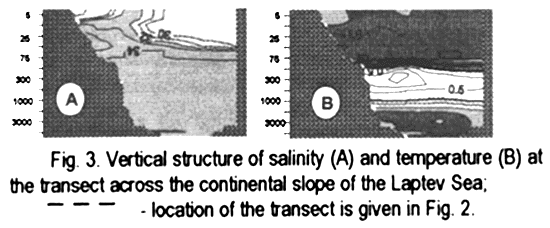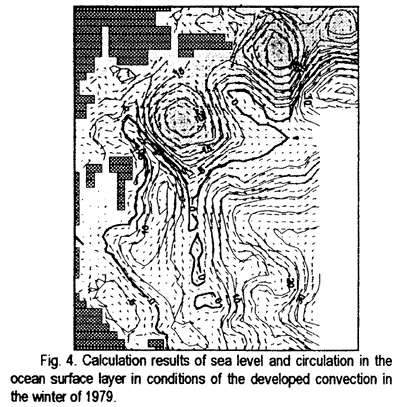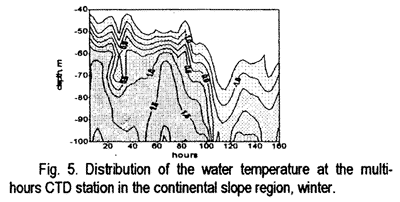convection zone is for 3-4 psu higher than in the shelf and Arctic surface waters being equal to 32.5-33.0 psu.Narrow regions of vertical frontal zones exist at the boundaries of the convection zones.

We should concentrate our attention on presence of two isolated water masses to the North and to the South off the continental slope divided by the vertical convection zone. The shelf water mass has salinity 28-30 psu and temperature-15-17℃. Salinity of the surface waters of the Arctic Basin is close to that of the shelf waters and equals 29-30 psu, its temperature being close to the freezing point. Salinity of the water mass in the convection zone is for 3-4 psu higher than in the shelf and Arctic surface waters being equal to 32.5-33.0 psu.Narrow regions of vertical frontal zones exist at the boundaries of the convection zones.
As one can see in Fig.3, the vertical convection nearly completely destroys halocline and reaches depths 150-200 m contributing partial heat release of the Atlantic waters.
The intensive convection in the region of the continental slope causes significant reconstruction of themohaline ocean circulation. Sea level and themohaline circulation in the Arctic Ocean in conditions of the developed winter convection in the winter of 1979 are presented in Fig.4. These fields have been obtained using numerical model (Pavlov and Pavlov, 1998;Pavlov, 1995). Presence of cyclonic eddy formations over the continental slope is a typical feature of the ocean circulation in conditions of the intensive convection. The greatest of these formations with diameters from 150 to 450 km are observed over the continental slope of the Kara and Laptev Seas.

Sea level decrease in centers of these formations reaches 30-40 cm reffering to the undisturbed sea surface. Calculations indicate that vertical extent of the eddies can be greater than depth of the Atlantic water kernel. In our opinion, upwelling observed in the cyclonic eddies can also be an important mechanism of the heat transfer from the Atlantic waters to the surface.
Processes of the internal wave type are the third important mechanism of the heat transfer and formation of the thermohaline structure of waters over the continental slope (Alekseev et al.,1974;Golovin and Lukin, 1993).
The continental slope is a zone of generation and destruction of internal waves (Baines, 1982). Furthrmore, effects of internal surf and generation of internal shelf waves (Rhines, 1970) might happen over the continental slope. Analysis of all available observation data in the region of the continental slope revealed presence of the internal waves and their intensity varies both spatially and temporally. The most intensive barocline processes are observed in the vicinity of shelf break. Internal wave values can be as high as several tens of meters (Fig.5).

Muench et al. (1997) point out significant energy increase of the internal waves over the continental slope of the Laptev Sea in comparison with the ocean (Levine et al.,1985).They estimate vertical heat flux as being in the range of 10-40 W m-2. Our estimate of the heat flux obtained using the same method (Gregg,1989) is 40-60 W m-2. Unfortunately there were no current measurements over the continental slope in winter period, so we used calculated velocities. It is our opinion that flux values can be much more in case of more accurate measurements of current velocities, for example, using ADCP.
Intensity of ocean dynamics over the continental slope is determined by parameters of the main elements of hydrologic conditions of the Arctic Ocean such as atmospheric circulation, air temperature, ice conditions, river runoff, advection of the warm Atlantic and Pacific waters. Small, long-term variations of these processes in certain combination can result in critical values of parameters of the winter convection and internal wave movements and can significantly reconstruct the thermohaline circulation over the continental slope. All this is a reason of rapid release of a large amount of heat and significant variations of the thermohaline structure of all the Arctic Ocean. Climatic signals can be, therefore, amplified in the region of the continental slope.
In order to support this concept we have calculated mean magnitude of the annual temperature and salinity cycle (Aannual) and mean magnitude of temperature and salinity variations in the course of four decades (50-s-80-s) (Adecade) for all the standard observation depths of the Arctic Ocean using data of the Joint US-Russian Atlas of the Arctic Ocean (1997). The CI value (ratio of these magnitudes calculated using the formula CI=Adecade*
BACK CONTENTS NEXT